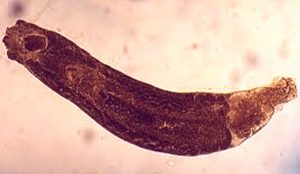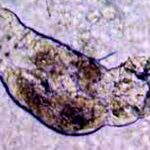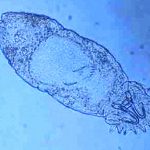Gill Flukes (Dactylogyrus) and Skin Flukes (Gyrodactylus) are common parasitic flatworms that affect fish, frogs, and turtles. Despite their names, both Trematoda can be found on the skin and gills of cold water and tropical fish where in small numbers do little harm to healthy fish. In large numbers, Flukes (Trematoda) are debilitating and often the cause of secondary bacterial infections.
There are over 10,000 species of Trematoda that occur worldwide. They range in size from about 0.2 inches to 4 inches in length and infect domestic animals, humans, mollusks, and crustaceans in addition to almost all tropical fish. Flukes can attach themselves externally, internally (in the gut), and semi externally in the gills and mouth of fish.
The Gill Fluke (Dactylogyrus) uses hooks on it’s body to attach itself to the flesh of the fish’s gills. As it multiplies, it reduces the ability of the fish to take in oxygen, the fish becomes listless and dies of oxygen starvation or from a bacteria infection.
Gill Flukes (Dactylogyrus) live for about a week and drop eggs which hatch out with 2 to 4 days. The larvae die without a host in about…..
PHYSICAL SYMPTOMS:
Gill Flukes and Skin Flukes are small, flat, white, worm like parasites that are difficult to spot without the aid of a microscope.
Symptoms include the following:
Gill Fluke (Dactylogyrus):
Loss of appetite
Fish becomes lethargic
Irritated, discolored, sloppy looking gills
Gasping at the surface
Skin Fluke (Gyrodactylus):
Rubbing and flashing
Tiny red spots or yellow dusting
Sores and ulcers
Clamped fins
Changes in the slime coat
In the more advanced stage of Gyrodactylus infestations, the fish become lethargic and will spend long periods on the bottom of the tank isolating itself with it’s fins clamped close to the body.
In the advanced stage of Dactylogyrus infestations, fish will often display swollen, discolored gills, and have no appetite. The gill covers may be clamped shut or remain wide open and the skin of the fish can be cloudy due to the excess amount of mucus being produced.
Severely infected fish will usually be gasping for air at the surface where the water has a higher concentration of oxygen, or laying at the bottom suffering from severe gill damage.
Severe infestations will kill fish directly or by secondary infections.
CAUSE:
Flukes (Trematoda) are caused by introducing infected fish or plants that carry the eggs of the parasite, or the adult parasite into a pond or aquarium.
TREATMENT:
Of the numerous Fluke treatments that are available to treat both live bearing and egg laying Trematatoda, those containing Praziquantel are the most effective.
Most Fluke treatments target the juvenile and adult stage which is satisfactory for Gyrodactylus, but for Gill Flukes (Dactylogyrus) and other egg laying Trematoda, several treatments are required over a period of several weeks to kill off the offspring of the hardy eggs. There is no fish safe treatment that will kill fluke eggs, which is why re-treatments are necessary to completely break the life cycle.
When there are large amounts of dissolved organic matter in the pond or aquarium water, repeated treatments after 7 days are definitely required.
Most tropical fish keeping enthusiasts use Praziquantel (prazi) as a safe, effective, “go to” treatment for Skin Flukes (Gyrodactylus sp.), Gill Flukes (Dactylogyrus sp.), and tapeworms in Koi, goldfish, and tropical fish. Although Praziquantel is primarily used to treat parasitic worm infections in humans and animals; it is also used in ponds, aquaculture, and aquariums.
Praziquantel, or prazi, is gentle on fish, safe to use with aquatic plants, and will not affect the biological filtration in your aquarium or pond.
Praziquantel is a white powder that is notoriously hard to dissolve in water, and the liquid form of prazi will often precipitate out of solution on the bottom of the container. It is sold by a variety of sources i.e. Pet Mountain, PondRx, Drs Foster and Smith, and others.
Tropical fish keeping enthusiasts have come up with a simple trick to dissolve prazi using a nylon stocking or bit of pantyhose. Just put the required dose in the stocking, tie it off, submerge it in the pond or aquarium, and gently roll it between your fingers until it all disperses. The dissolved prazi will immediately come out of the stocking and look like a white cloud as it is dispersed into the tank or pond water.
For pond applications:
- Remove all carbon from the pond filter
- Turn off the ultraviolet sterilizer
- Dose at a rate of 1 gram per 100 gallons of pond water for prolonged treatment.
- Reapply after 4 or 5 days if needed
- A partial water change can be made a week after the last application but is not required.
For live bearing Skin Flukes, one treatment is usually enough to kill both adult and juveniles. With extremely heavy infestations, a second treatment is suggested.
For egg bearing Gill Flukes, two treatments spaced 4 or 5 days apart are necessary. The first treatment kills the adults and juveniles, but not the eggs. The second followup treatment 5 days later will kill the newly hatched eggs.
For aquarium applications:
Fish Tapes from Thomas Labs is Praziquantel in 34 mg tablets or loose powder form.
Capsules:
- After vacuuming the tank and making a water change, distribute the contents of one 34 mg capsule into the aquarium for every 4 gallons of water.
- Remove all activated carbon and discontinue UV sterilization, but do not stop filtration.
- One 5 to 7 day treatment is generally sufficient.
- Do not apply more than once every 3 to 5 days.
- Do not mix with any other drugs.
Loose Powder:
- For every 4 gallons of aquarium water, evenly distribute 1 level tsp of Praziquantel powder around the perimeter of the tank or directly into the filter.
- Remove all activated carbon and discontinue UV sterilization, but do not stop filtration.
- One 5 to 7 day treatment is generally sufficient.
- Do not apply more than once every 3 to 5 days.
- Do not mix with any other drugs.
After the Flukes are eradicated, treat the tank with a general bacteria cure.
PREVENTION:
Poor water quality and warm temperatures accelerate the reproductive cycle of Flukes (Trematoda), and because the life cycle of monogenean Flukes do not require an intermediate host, they can remain in a closed aquarium environment almost indefinitely.
The best prevention for Fluke infestations is to quarantine all fish and plants before introducing them into your pond or aquarium. Because Flukes are microscopic and difficult to detect visually, new additions to your system should be watched carefully.
Maintaining pristine water quality and controlling the waste levels in the system is important in reducing existing Fluke populations and to ensure that the fish maintain a healthy immune system.
Manage Fluke infestations with Prazinaqantel, mebendazole, toltrazuril, formalin, organophosphates, or with salt (or freshwater for marine fish) baths.




